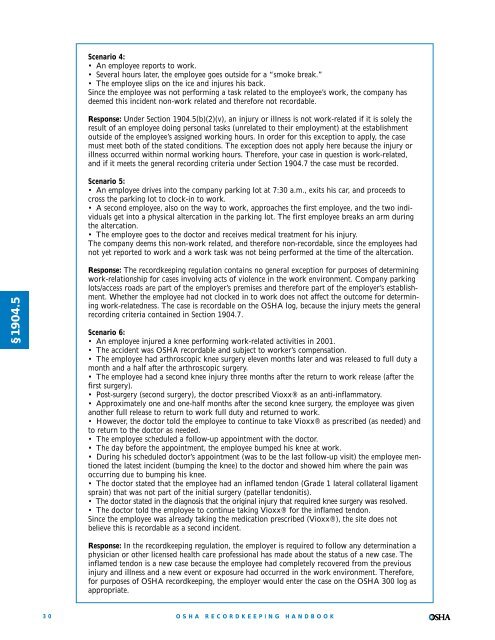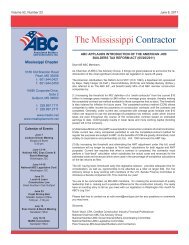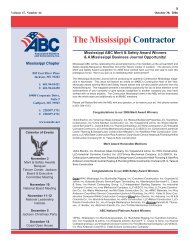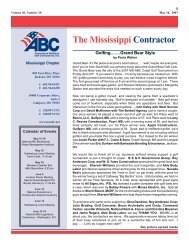OSHA Recordkeeping Handbook - Msabc.net
OSHA Recordkeeping Handbook - Msabc.net
OSHA Recordkeeping Handbook - Msabc.net
Create successful ePaper yourself
Turn your PDF publications into a flip-book with our unique Google optimized e-Paper software.
Scenario 4:• An employee reports to work.• Several hours later, the employee goes outside for a “smoke break.”• The employee slips on the ice and injures his back.Since the employee was not performing a task related to the employee’s work, the company hasdeemed this incident non-work related and therefore not recordable.Response: Under Section 1904.5(b)(2)(v), an injury or illness is not work-related if it is solely theresult of an employee doing personal tasks (unrelated to their employment) at the establishmentoutside of the employee’s assigned working hours. In order for this exception to apply, the casemust meet both of the stated conditions. The exception does not apply here because the injury orillness occurred within normal working hours. Therefore, your case in question is work-related,and if it meets the general recording criteria under Section 1904.7 the case must be recorded.Scenario 5:• An employee drives into the company parking lot at 7:30 a.m., exits his car, and proceeds tocross the parking lot to clock-in to work.• A second employee, also on the way to work, approaches the first employee, and the two individualsget into a physical altercation in the parking lot. The first employee breaks an arm duringthe altercation.• The employee goes to the doctor and receives medical treatment for his injury.The company deems this non-work related, and therefore non-recordable, since the employees hadnot yet reported to work and a work task was not being performed at the time of the altercation.§1904.5Response: The recordkeeping regulation contains no general exception for purposes of determiningwork-relationship for cases involving acts of violence in the work environment. Company parkinglots/access roads are part of the employer’s premises and therefore part of the employer’s establishment.Whether the employee had not clocked in to work does not affect the outcome for determiningwork-relatedness. The case is recordable on the <strong>OSHA</strong> log, because the injury meets the generalrecording criteria contained in Section 1904.7.Scenario 6:• An employee injured a knee performing work-related activities in 2001.• The accident was <strong>OSHA</strong> recordable and subject to worker’s compensation.• The employee had arthroscopic knee surgery eleven months later and was released to full duty amonth and a half after the arthroscopic surgery.• The employee had a second knee injury three months after the return to work release (after thefirst surgery).• Post-surgery (second surgery), the doctor prescribed Vioxx® as an anti-inflammatory.• Approximately one and one-half months after the second knee surgery, the employee was givenanother full release to return to work full duty and returned to work.• However, the doctor told the employee to continue to take Vioxx® as prescribed (as needed) andto return to the doctor as needed.• The employee scheduled a follow-up appointment with the doctor.• The day before the appointment, the employee bumped his knee at work.• During his scheduled doctor’s appointment (was to be the last follow-up visit) the employee mentionedthe latest incident (bumping the knee) to the doctor and showed him where the pain wasoccurring due to bumping his knee.• The doctor stated that the employee had an inflamed tendon (Grade 1 lateral collateral ligamentsprain) that was not part of the initial surgery (patellar tendonitis).• The doctor stated in the diagnosis that the original injury that required knee surgery was resolved.• The doctor told the employee to continue taking Vioxx® for the inflamed tendon.Since the employee was already taking the medication prescribed (Vioxx®), the site does notbelieve this is recordable as a second incident.Response: In the recordkeeping regulation, the employer is required to follow any determination aphysician or other licensed health care professional has made about the status of a new case. Theinflamed tendon is a new case because the employee had completely recovered from the previousinjury and illness and a new event or exposure had occurred in the work environment. Therefore,for purposes of <strong>OSHA</strong> recordkeeping, the employer would enter the case on the <strong>OSHA</strong> 300 log asappropriate.30<strong>OSHA</strong> RECORDKEEPINGHANDBOOK







